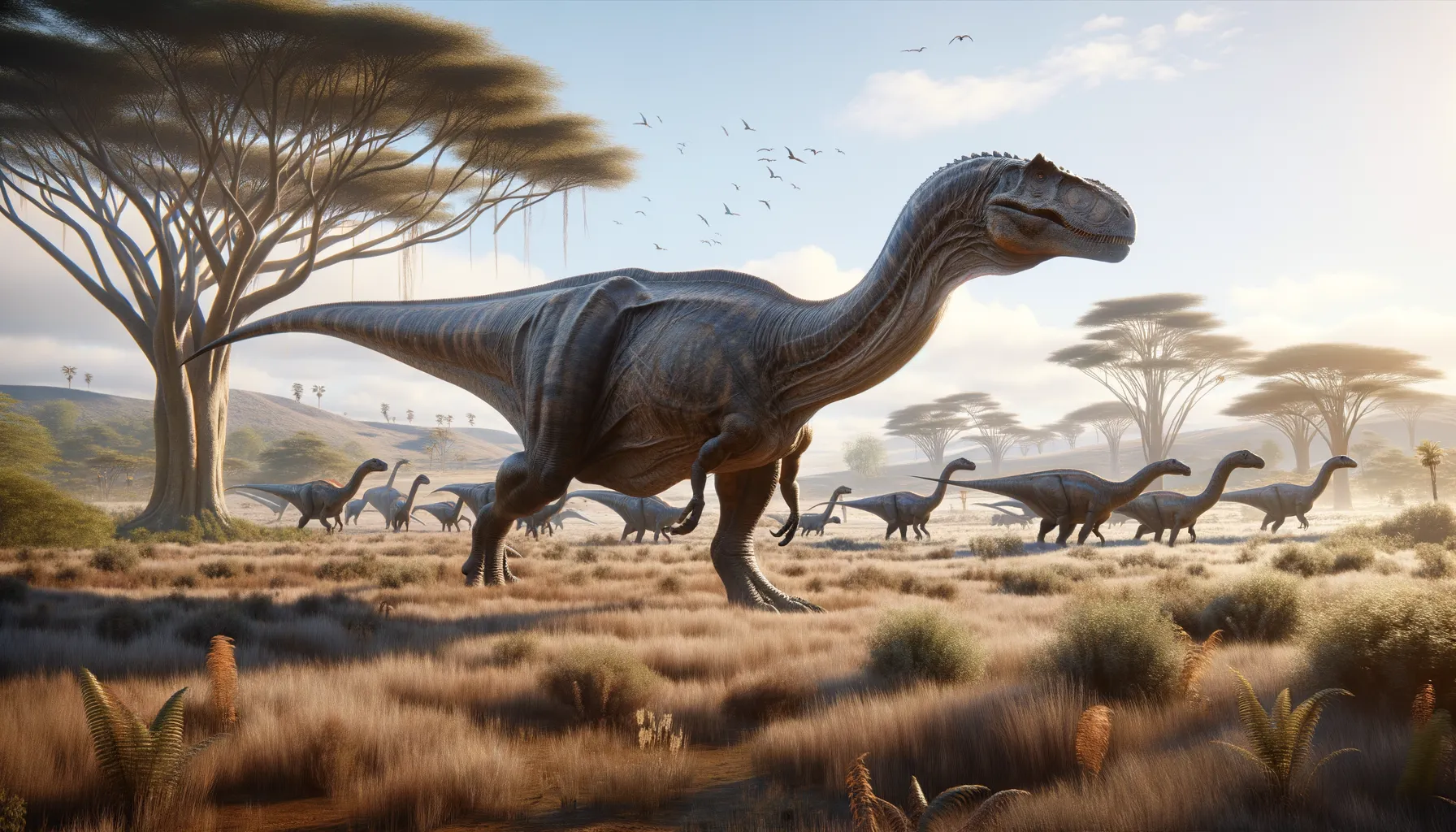
Savannasaurus
Ancient giant of the Australian Outback!
Period
Cretaceous
Length
Measured about 15 meters long.
Height
Stood approximately 3 meters tall.
Weight
Weighed around 20 tons.
Savannasaurus was a colossal plant-eating dinosaur that roamed the ancient landscapes of what is now Australia over 95 million years ago. It belonged to the titanosaur group of dinosaurs, which are characterized by their long necks, massive bodies, and relatively small heads. Despite its size, this gentle giant likely moved in herds and exhibited social behavior, offering protection and increasing chances of survival.
Diet
Savannasaurus was strictly herbivorous, primarily feasting on a variety of prehistoric plants that proliferated in its environment. Its long neck allowed it to reach vegetation at both ground level and higher up in trees, giving it access to a diverse range of food sources.
Hunting
As a herbivore, Savannasaurus did not hunt. Instead, it foraged extensively across its habitat, using its massive body and strength to push through dense foliage and reach its nutritious meals scattered across the landscape.
Environmental challenges
During the Cretaceous period, Savannasaurus faced fluctuating climates which affected plant availability. Changes in vegetation patterns due to these shifts could have posed challenges in locating sufficient food. Additionally, the presence of predatory dinosaurs would have been a constant threat, urging these peaceful giants to maintain vigilance and rely on their social structure for safety.
Speed
Walked slowly due to its massive size.
Lifespan
Estimated to be several decades long.
First discovery
First unearthed in the Outback of Australia.
Fun Facts
- Savannasaurus was a type of dinosaur known as a sauropod, which means it had a long neck and big body similar to famous giants like Brachiosaurus.
- It lived roughly 95 million years ago during the Cretaceous period.
- Fossils of Savannasaurus were discovered in Queensland, Australia, making it one of the few dinosaurs from that region with such unique characteristics.
- Despite its massive size, Savannasaurus had a relatively small head compared to its long neck and body.
- This dinosaur's name 'Savannasaurus' highlights the type of environment it lived in, as it is believed to have roamed ancient savannah-like landscapes.
- Savannasaurus used its long neck to reach high vegetation and its strong legs to travel vast distances in search of food.
- It was a plant-eater, or herbivore, spending most of its day munching on leaves, ferns, and possibly conifers.
Growth and Development
Savannasaurus hatchlings likely experienced rapid growth, requiring substantial food intake to reach their imposing adult size. Juveniles might have stayed in protective groups to shield themselves from predators. As they matured, their robust bones and muscular structure facilitated their development into powerful, sturdy adults.
Habitat
Savannasaurus lived in the semi-arid landscapes of ancient Australia, which featured diverse flora suitable for a herbivore. They roamed open spaces interspersed with patches of forest, exploiting the resources these areas had to offer. The climate was temperate, supporting a variety of plants which served as the primary food source.
Interaction with other species
While mainly peaceful, Savannasaurus had to cohabit with both herbivorous and carnivorous species, maintaining a delicate balance in the ecosystem. They might have joined forces with other herbivores to mutually benefit from shared vigilance against predators. Inter-species interactions would have been crucial in navigating the dynamic challenges of their environment.
Natural lifespan
In the wild, Savannasaurus could live for several decades.
Reproduction
Reproduction likely involved internal fertilization with females laying eggs, possibly in communal nesting grounds. Hatchlings emerged from leathery eggs and quickly sought safety within the herd. The nurturing environment of the group might have been vital for juvenile survival amid potential threats.
Social behaviour
Savannasaurus were social creatures, often traveling in herds to provide collective security against predators. Such grouping behavior would have also facilitated communication and cooperation in foraging and raising young. They might have shown signs of communal care, particularly when rearing offspring.
Fossil locations
Fossils of Savannasaurus have been primarily found in Australia, offering valuable insights into the continent's prehistoric ecosystem. The discovery sites included well-preserved remains that have allowed paleontologists to reconstruct aspects of its lifestyle and environment. Fossil evidence reinforces its classification within the titanosaur group.
